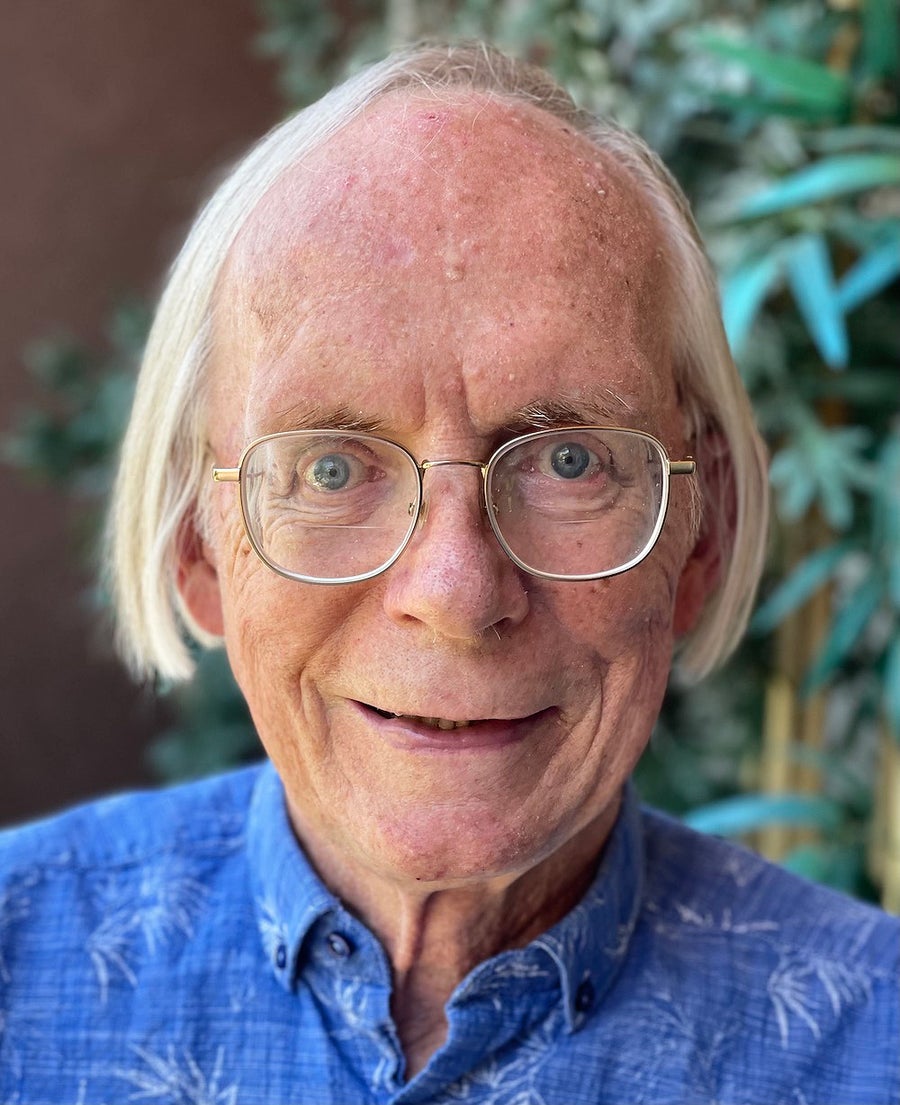What happens when matter transitions from one phase to another—a solid to a liquid or a liquid to a gas? Describing these critical points precisely, in solvable mathematical terms, is no simple feat. And for theoretical physicist John Cardy, work in this area has led to insights into everything from the way fluids percolate through a network of pores to calculations of the entropy of black holes.
Cardy is one of the key developers of conformal field theory, which is a type of quantum field theory concerned with systems that look the same under translations (or movements) in any direction, rotations or scale transformations (changes in size). Imagine blowing up a photograph by a constant factor and seeing something that looks, on average, the same as the original. Going one step further, imagine blowing up that same photograph by different factors in different places. The image will be distorted, but the angles between lines will be preserved. This is called a conformal transformation. As it turns out, this kind of invariance is a key property for matter about to flip from one phase to another.
Conformal field theory acts as a bridge between different fields of physics: the underlying math is used in string theory, condensed matter physics and quantum statistical mechanics. Cardy’s formulas can describe the entropy of certain kinds of two-dimensional black holes that are used as models of the real thing. They can describe how fluids move through networks of pores when new nodes are added. This explains quantitatively why your morning coffee takes longer to percolate through a tall, narrow filter than a short, wide one, but it also has a lot of implications for fundamental physics. (More on this below.)
On supporting science journalism
If you're enjoying this article, consider supporting our award-winning journalism by subscribing. By purchasing a subscription you are helping to ensure the future of impactful stories about the discoveries and ideas shaping our world today.
Cardy, age 76, is being honored for this lifetime of contributions with a Breakthrough Prize, a prestigious award founded in 2012 by Silicon Valley innovators. Cardy is splitting the 2024 Breakthrough Prize in Fundamental Physics with Alexander Zamolodchikov, another giant of quantum field theory now at Stony Brook University.

Professor John Cardy, All Souls College, University of Oxford, Co-winner, 2024 Breakthrough Prize in Fundamental Physics. Credit:
澳门六合彩投注 caught up with Cardy, an emeritus fellow at All Souls College of the University of Oxford, to talk about the work that earned the 2024 prize.
[An edited transcript of the interview follows.]
How does it feel to have won this prize?
I’m very, very pleased that the Breakthrough committee has chosen to recognize my work in this particular way. I don’t work in particle physics or cosmology; I work in condensed matter physics. But my work is as fundamental as any work in those areas because the mathematics we use to describe it is very similar to work in string theory and that kind of thing. I’m happy.
How do you explain to people outside of physics what your research is about?
I work in statistical physics, which deals with any situation where you have a large number of things. That could be molecules, or atoms, or stars in the galaxy or people in a large crowd, even. This subject was, in fact, invented in the 19th century, but the thing that became of interest toward the end of the 20th century was using statistical physics to describe different states of matter and, in particular, to try to explain the phase transitions that happen when you go from one state of matter to another, such as from a solid to a liquid, for example.
In the late 1960s and early 1970s it was realized that these phase transitions can be described by the same kind of quantum field theory that had already been developed to understand elementary particle physics. It was the same mathematical structure.
But the kind of quantum field theories that we were dealing with aren’t the weakly interacting kinds that people had looked at in previous contexts. [Weak and strong interactions are two fundamental forces in physics. Strong attractions hold together subatomic particles such as protons and neutrons, and weak interactions govern radioactive decay.] One had to somehow develop the kinds of mathematics that could treat the system as a whole as strongly interacting. That came along in the 1980s when there were a series of papers by some Russian physicists, including Zamolodchikov, who I’m sharing the award with.
It’s a subject called conformal field theory. It turns out that these [conformal] systems, when they’re at phase transitions, have very special geometric properties that allow for some strong constraints that let you solve them exactly—not in some approximation.
We don't really think about something such as phase transitions in fluids flowing through a network of pores such as a coffee filter. What is the phase transition that occurs in this situation?
Instead of temperature, the control parameter is the proportion of pores that are open. We imagine that each pore is open with probability p and closed with probability 1 – p independently. If p is small, the fluid doesn't flow through the network; if p is close to 1, it does. Somewhere in between is a critical value, called the percolation threshold, at which the fluid begins to flow all the way across the network. It turns out that the percolation threshold is analogous to the critical temperature. We get universal power laws, and the system is scale invariant: if you take a photograph of the fluid flowing through the pores and blow it up, it looks like the original. It is also conformally invariant: if you blow up the photograph by different factors in different places, it also looks the same—at least on large enough scales.
In two dimensions, conformal invariance using conformal field theory was powerful enough to predict the exact values of the critical exponents (the indices of the power laws), as well as the shape dependence. For example, how does the probability that the fluid can flow from top to bottom across a rectangle depend on the ratio of its height to its width? This is the Cardy formula.
To get ridiculously concrete with it, why does this—as you said—explain why your morning coffee is slower to percolate through a tall, narrow filter? What's the physical process that this math is describing?
In a wider filter, there are more potential paths for the fluid to take. If it is taller, however, each path has to go farther.
How did your work open these new doors for mathematicians to solve problems related to percolation theory?
This result puzzled mathematicians who had been working on these kinds of problems. In fact, the story is as follows: I got a message from a mathematician at Princeton University saying that they had numerical evidence that this quantity might be universal (that is, independent of microscopic details), and did I know the precise formula? I thought about it for a week or so and came up with the formula. But to be sure, I asked them to send me their data before I sent them the formula. When I overlaid the graph of their data on my predicted curve, it fit perfectly! It was one of those aha! moments one sometimes, but rarely, gets in science.
The mathematicians were not happy about my nonrigorous arguments, however. A different group developed a different approach called Schramm–Loewner evolution (SLE), which describes the actual path that the fluid takes as it percolates through the network. After a lot of mathematics, this reproduces my formula and gives many other results.
Why is this kind of work so important?
A lot of the public has the idea that in order to be fundamental, physics has to be either very small—particle physics or string theory—or it has to be cosmology. But there is this modern idea of emergence that on different scales of energy and distance, new phenomena arise. A good example is superconductivity in a metal, which is described by quantum field theory.
You can develop the theory of a superconductor without knowing anything about particle physics. The actual description is in terms of quantum fields. It’s just as interesting and just as fundamental, in a way. We can think about waves on the ocean. They’re described by equations which are sufficient enough to explain everything we know about waves, but we don’t need to know they’re made out of water molecules. This idea of emergence has developed rather gradually. It’s a different way of understanding how the different sciences relate to one another.
What is the “quantum quench”?
I’m quite proud of having coined that term! It’s an obvious term because it rolls off the tongue. A quench means when you change the external parameters of an experiment almost instantaneously. The name comes from subjects such as metallurgy. When you quench an alloy, you heat it up, and then you plunge it into cold water and alter the temperature almost instantaneously. That freezes the impurities in the alloy in place. That’s what we call a thermal quench.
So a quantum quench is when you have a quantum system that you prepare in a certain state, and then you change a magnetic field or something and watch what happens. All sorts of many-body quantum effects occur. The interesting thing is the way the quantum entanglement of the system grows as a function of time. [Entanglement refers to particles that are linked to one another despite being physically far apart; in a system of growing quantum entanglement, more particles will become linked over time.] I realized that conformational field theory was a good model for this kind of process. You can’t really simulate this on a digital computer because it’s too complicated. It will take longer than the age of the universe to simulate this kind of problem. You can do it on a quantum computer—I’m not an expert on quantum computing, but I’ve done this, which has informed some of that work.
Are there any other aspects of your work that were particularly rewarding?
It’s all rewarding. Ever since I was quite young, I thought I was going to be a scientist, though obviously at that age I didn’t realize exactly what it entailed. I am very pleased I was able to make a success of it because there were certainly times when I was younger, as a graduate student and a postdoc, when it seemed really, really hard.
I understand you have spent a lot of time climbing. Does that hobby scratch a similar itch to physics, or is it a total escape?
I started climbing as a teenager, and I have always tried to fold that in with my work and my travel. There are a lot of physicists and mathematicians who are interested in climbing. It’s something to do with problem-solving, but the thing about climbing is that you have to solve the immediate problem in front of you in a cool way so you don’t panic or fall off. The other aspect is just being out in nature and the beauty of the mountains.
Now I paint. I love to get out into the mountains, so even though I’m not as energetic and can’t climb them these days, I enjoy just painting them.
I was diagnosed with Parkinson’s about five or six years ago, and I’m really pleased to see that there is also going to be a for the study of Parkinson’s. [Researchers Thomas Gasser, Ellen Sidransky and Andrew Singleton are sharing that prize for their discovery of risk genes for the neurological disease.] It’s something that affects more than one million Americans and more worldwide, and it’s actually increasing. People should understand that (a) a lot of people have it, and (b) it doesn’t stop them living and pursuing a meaningful life.
